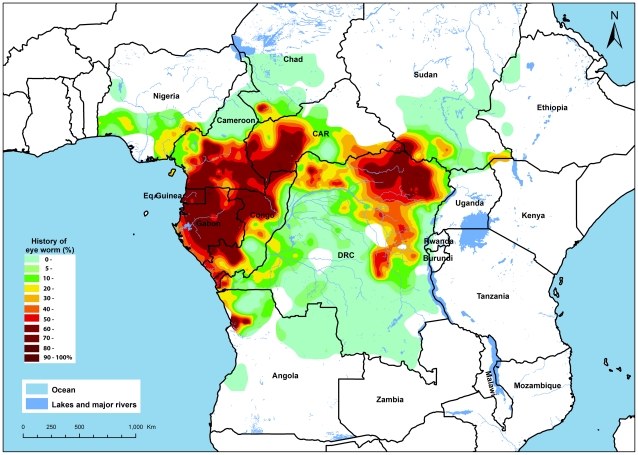Habitat
What areas do I avoid?
One of the first records of an
infection of the Loa loa involved in 1707 features a
young girl in Santo Domingo, Dominican Republic suffering from
“severe stabbing eye pain.” A surgeon subsequently extracted a
worm from her eye (Padgett and Jacobsen 2008). Today, Loa loa infects millions of people from West and Central
Africa (Padgett and Jacobsen 2008). An estimated 30 million
people live at risk of contracting this parasite (Antinori et
al. 2012). Cases occur most often in rainforests of
Cameroon, with a 54% endemic, as well as the Republic of the
Congo, the Democratic Republic of Congo, the Central African
Republic, Gabon, Equatorial Guinea, and Nigeria (Padgett and
Jacobsen 2008). However, cases in Western countries are becoming
more common because of travelers and immigrants who visit the
endemic areas (Padgett and Jacobsen 2008, Antinori et al.
2012).
Inhabiting human inhabitants
 While the Loa loa primarily
inhabits African countries, they dwell within two different
hosts during their life cycle.
So, as far as their habitat goes it spends the
larva stage within flies of the genus
Chrysops. These bloodsucking flies t
While the Loa loa primarily
inhabits African countries, they dwell within two different
hosts during their life cycle.
So, as far as their habitat goes it spends the
larva stage within flies of the genus
Chrysops. These bloodsucking flies t blood during the day
for a chance to transfer their eggs through the blood when the
fly has a blood meal from infected human host (Padgett and
Jacobsen 2008). At night, they dwell in the vascular section of
the lungs (Padgett and Jacobsen 2008). They depend on the fluids
from the tissues of humans and use secreted digestive enzymes to
obtain these nutrients (Harris 2003). The likelihood of
contracting this parasite increases when you are within wet
areas, like the rainforest or swamps, during the rainy season
because these conditions are more favorable for the fly
population, the transmitters to humans (Padgett and Jacobsen
2008). So, Loa loa thrives all
over Africa as well as some western countries due to immigration
and travelers, but only within two different organisms at
certain points of their life cycle
(Padgett and Jacobsen 2008).
blood during the day
for a chance to transfer their eggs through the blood when the
fly has a blood meal from infected human host (Padgett and
Jacobsen 2008). At night, they dwell in the vascular section of
the lungs (Padgett and Jacobsen 2008). They depend on the fluids
from the tissues of humans and use secreted digestive enzymes to
obtain these nutrients (Harris 2003). The likelihood of
contracting this parasite increases when you are within wet
areas, like the rainforest or swamps, during the rainy season
because these conditions are more favorable for the fly
population, the transmitters to humans (Padgett and Jacobsen
2008). So, Loa loa thrives all
over Africa as well as some western countries due to immigration
and travelers, but only within two different organisms at
certain points of their life cycle
(Padgett and Jacobsen 2008).

